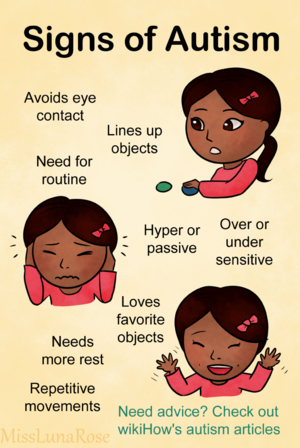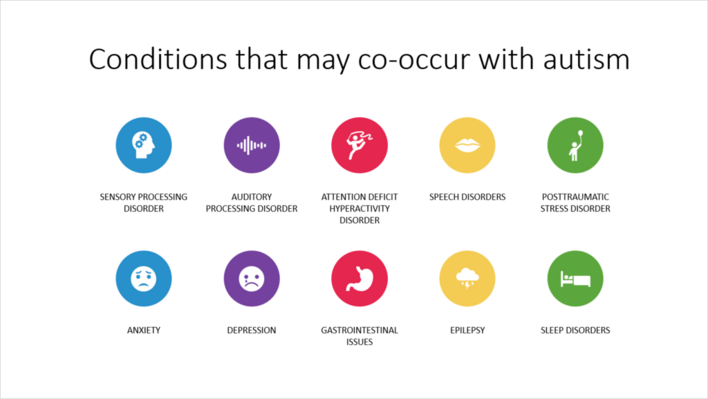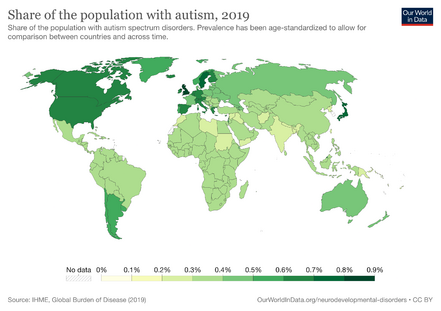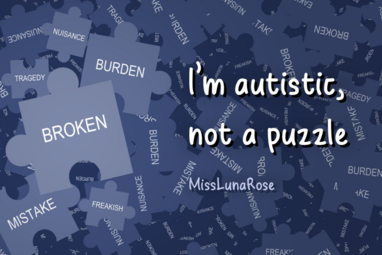Autism Spectrum Disorder
'Original Editor - Kirenga Bamurange Liliane Top Contributors - Kirenga Bamurange Liliane, Lucinda hampton, Jess Bell, Kim Jackson, Naomi O'Reilly, Nupur Smit Shah and Robin Tacchetti
Introduction[edit | edit source]
Autism, referred to as Autism Spectrum Disorder (ASD), is a neurodevelopmental disorder that affects the way an individual with ASD relates to others and to their environment.[1][2]
Autism traits may be evident in childhood, but some individuals will not be diagnosed until later in life. Some individuals may have significant disabilities and require ongoing care while others live independently.[3]
Autism can affect an individual's education and employment opportunities, and may add stress to the families providing care and support.[3]
In the video below, the neuroscience of autism along with potential factors and mechanisms involved in the development of autism are discussed (2 minutes).
Co-occurring Conditions[edit | edit source]
Individuals with ASD frequently have co-occurring conditions (eg epilepsy, depression, anxiety and attention deficit hyperactivity disorder) and other challenging behaviours (eg difficulty sleeping and self-injury). The level of intellectual functioning also varies greatly among individuals with ASD. Some may experience profound impairment whereas others have average or higher IQs.[3][5]
Aetiology/Epidemiology[edit | edit source]
"ASD is a neurobiological disorder influenced by both genetic and environmental factors affecting the developing brain."[2]
Research into the aetiological mechanisms of ASD is ongoing, but at present, no single cause for this condition has been identified.[2]
- The reported prevalence of ASD is 1 in 68 individuals.[6]
- Prevalence rates vary between countries.[7]
- The general prevalence of ASD is increasing globally.[7] However, it should be noted that this might be due to increased awareness of ASD, potential overdiagnosis, or diagnostic criteria that are over-inclusive.[6]
Signs and Symptoms[edit | edit source]
Challenges that people with autism face might include:[1]
- struggling to communicate their needs and desires
- having difficulty interpretating what other people mean
- their ability to process sensory and cognitive information might be impacted
Children and youth with ASD have different intellectual abilities. Individuals with ASD might have limited or no verbal communication, and very limited adaptive behaviour.[8] [3]
Risk Factors[edit | edit source]
The following factors have been linked to ASD:
- Hereditary factors, parental history of psychiatric disorders, pre-term births.
- Parental age ( advance maternal and paternal age)
- Maternal history of autoimmune disease such as diabetes, thyroid disease and psoriasis. [2]
- Prenatal exposure to psychotropic drugs or insecticides like thalidomide and valproic acid. [2]
- Some of the known genetic disorders such as fragile X, tuberous sclerosis, Down syndrome, Rett syndrome even though they represent a very small amount of overall ASD cases [2].
- Maternal infection or immune activation during pregnancy
- Obstetric factors like uterine bleeding, caesarian delivery, low birth weight, preterm delivery, and low Apgar scores are more consistently associated with autism[2].
Diagnosis[edit | edit source]
ASD can be diagnosed by various professionals, ideally with input from multiple disciplines[9].
- Diagnoses based on combined clinician observation and caregiver reports are consistently more reliable than those based on either observation or reports alone.
- Later diagnoses often occur in presence of co-occurring problems such as anxiety, hyperactivity, or mood disorders that might have triggered the ASD, along with the same factors that play a part in delayed diagnoses in younger children. [9]
- There is a need for clinical follow-up and reassessments of children diagnosed with ASDs, especially during the preschool years[10].
- There are currently no clear existing ASD biomarkers or diagnostic measures. The diagnosis is made based on the completion of descriptive criteria. [2].
To identify early symptoms of ASDs and sometimes help make a definitive diagnosis, different approaches/tools are used in different countries. The following ones are used :[11]
- The Modified Checklist for Autism in Toddlers, Revised (M-CHAT-R). A screener that asks a series of 20 questions about the child’s behavior. It's intended for toddlers between 16 and 30 months of age. See here
- CARS: Childhood Autism Rating Scale. The form is used with individuals of all ages and in both clinical and research settings.
- ADOS : Autism Diagnostic Observation Schedule. A standardised, semi-structured observational assessment of features relevant to the diagnosis of ASD across the lifespan.
Asperger’s syndrome is an outdated name for people who have a high-functioning form of autism spectrum disorder. There is no longer a separate diagnosis for Asperger's syndrome, although some people may prefer to keep using this term.[1]
Treatment[edit | edit source]
There are lots of autism treatments, with the right ones needing to be being specific to the individual in regards to needs and challenges. Selecting the correct treatments is a collaborative affair, between health professionals, the individual and caregivers.
The more common treatments for autism include:
- Behavioural Therapies: aim to improve specific behaviours and develop skills, and employs orthodox behaviour strategies, for example rewarding suitable behaviors and ignoring/discouraging inappropriate behaviours.[12]
- Occupational Therapy: concentrate on adaptive skills needed for activities of daily living (ADLs).
- Sensory Therapy. Numerous sensory interventions have been developed to normalise various sensory-challenges including sensory, visual and auditory interventions.[12]
- Speech Therapy: improve the child's speech pattern and language understanding.[13]
- Physical Therapy: improve physical and motor skills. You can read more about the Physiotherapy Management on this page. Physiotherapy for Autism Spectrum Disorder Children With Motor Control Disabilities
- Complementary and alternative treatments including chiropractic care, animal therapy, art therapy, music therapy, or relaxation therapies are also used as treatment options for people with ASD [14].
- Medications may be are used to treat the symptoms. The following can be used if agreed upon:
- Antipsychotic medications for repetitive behavior patterns and aggression
- Serotonin reuptake inhibitors (SSRIs)
- Stimulants, and other antipsychotics for problematic behaviours (like aggression) etc.[6]
Prognosis[edit | edit source]
Autism is a lifelong condition with an extensive variety of treatments available. Early intervention gives the best results. Any ADS treatment should be sought from qualified medical professionals.
Autism Low Resource Settings[edit | edit source]
The prevalence of autism in many low and middle-income countries is unknown.[3] Research about the ASD diagnosis process in LMICs is still limited. The mean age at ASD diagnosis was very similar across LMICs but older than in high-income countries [15]. Studies are required, specifically, epidemiological studies, to define the magnitude of the problem of ASD in LMICs[16]. The scarcity of these studies is due to different barriers including: [15]
- Lack of knowledge about epidemiological research
- Need of contextualization of research tools
- Shortage of experienced health professionals
- Stigma and lack of awareness about ASDs among these professionals (health, social and educational care)
ASDs in LMICs currently face many barriers, however efforts to raise awareness about ASDs through different organizations and institutions is ongoing. There is a need for research infrastructure, funding, and capacity, and inclusive education policies. This will help with an improvement in the quality of life of people with ASD and bring their acceptance into society.
References[edit | edit source]
- ↑ 1.0 1.1 1.2 The spectrum What is autism? Available:https://thespectrum.org.au/autism/#what-is-asperger%E2%80%99s-syndrome? (accessed 5.1.2023)
- ↑ 2.0 2.1 2.2 2.3 2.4 2.5 2.6 2.7 Hodges H, Fealko C, Soares N. Autism spectrum disorder: definition, epidemiology, causes, and clinical evaluation. Translational pediatrics. 2020 Feb; 9(Suppl 1): S55.
- ↑ 3.0 3.1 3.2 3.3 3.4 World health organisation Autism Available:https://www.who.int/news-room/fact-sheets/detail/autism-spectrum-disorders (accessed 5.1.2023)
- ↑ Neuroscientifically challenged. 2-Minute Neuroscience: Autism. Available from: https://www.youtube.com/watch?v=tEBsTX2OVgI [Accessed, 5.1.2023]
- ↑ Autism Research Institute. Average or high IQ in individuals with ASD may be higher than previously estimated. Available from: https://autism.org/average-or-high-iq-in-individuals-with-asd-may-be-higher-than-previously-estimated/ (last accessed 28 April 2023).
- ↑ 6.0 6.1 6.2 Mughal S, Faizy RM, Saadabadi A. Autism spectrum disorder (regressive autism, child disintegrative disorder). New York: StatPearls‑NCBI Bookshelf. 2020.Available:https://www.ncbi.nlm.nih.gov/books/NBK525976/ (accessed 5.1.2023)
- ↑ 7.0 7.1 Salari N, Rasoulpoor S, Rasoulpoor S, Shohaimi S, Jafarpour S, Abdoli N, Khaledi-Paveh B, Mohammadi M. The global prevalence of autism spectrum disorder: a comprehensive systematic review and meta-analysis. Ital J Pediatr. 2022 Jul 8;48(1):112.
- ↑ Steinbrenner JR, Hume K, Odom SL, Morin KL, Nowell SW, Tomaszewski B, Szendrey S, McIntyre NS, Yücesoy-Özkan S, Savage MN. Evidence-Based Practices for Children, Youth, and Young Adults with Autism. FPG Child Development Institute. 2020.
- ↑ 9.0 9.1 Lord C, Elsabbagh M, Baird G, Veenstra-Vanderweele J. Autism spectrum disorder. The lancet. 2018 Aug 11;392(10146):508-20.
- ↑ Fernell E, Eriksson MA, Gillberg C. Early diagnosis of autism and impact on prognosis: a narrative review. Clinical epidemiology. 2013;5:33.
- ↑ Parmeggiani A, Corinaldesi A, Posar A. Early features of autism spectrum disorder: a cross-sectional study. Italian journal of pediatrics. 2019 Dec;45(1):1-8.
- ↑ 12.0 12.1 Autism research institute Treatment Information and Resources Available:https://www.autism.org/treatment/ (accessed 5.1.2023)
- ↑ Alpert JS. Autism: A Spectrum Disorder. The American Journal of Medicine. 2021 Jun 1;134(6):701-2.
- ↑ Treatment and Intervention Services for Autism Spectrum Disorder. Available from: https://www.cdc.gov/ncbddd/autism/treatment.html ( Accessed, 17/03/2022).
- ↑ 15.0 15.1 van’t Hof M, Tisseur C, van Berckelear-Onnes I, van Nieuwenhuyzen A, Daniels AM, Deen M, Hoek HW, Ester WA. Age at autism spectrum disorder diagnosis: A systematic review and meta-analysis from 2012 to 2019. Autism. 2021 May;25(4):862-73.
- ↑ Bakare MO, Munir KM. Autism spectrum disorders (ASD) in Africa: a perspective. African journal of psychiatry. 2011 Jul 1;14(3):208-10.











